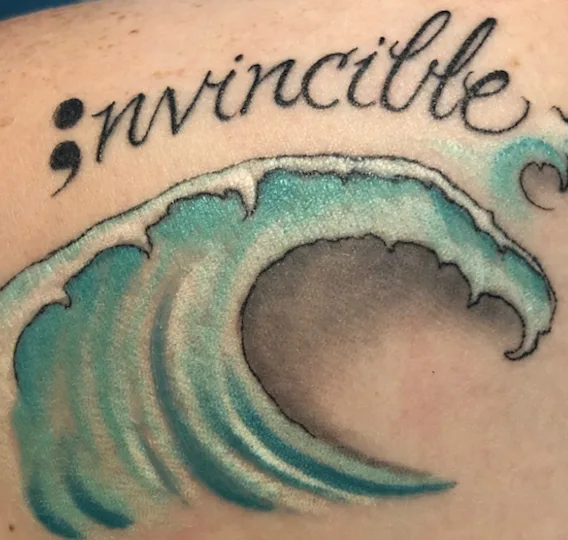What does a Semicolon tattoo mean?
A semicolon is a punctuation mark used to emphasise a pause in a sentence, so you might assume this tattoo is a favourite with frustrated English teachers or grammar pedants.
In fact, it has become a symbol of a person’s struggle with mental illness, and contemplation of suicide as well as their determination to keep fighting and move on.
How did Project Semicolon Tattoo start?
The founder of Project Semicolon, Amy Bleuel, was sexually assaulted in her youth and lost her father to suicide. She started the movement as a way not only to cope with her battle with depression, self-harm, and her own thoughts of suicide but to make a difference and help others going through the same struggles and stigma. Sadly, Bleuel ended her own life in 2017.
Through a social media post, Bleuel encouraged those who were going through depression, anxiety, self-harm, or thoughts of suicide to draw a semicolon on their wrist to show solidarity. The symbol signifies struggles with mental illness, suicidal thoughts or the loss of a loved one to suicide and the strength to move beyond those things and keep living.
“A semicolon represents a sentence the author could’ve ended but chose not to. The author is you and the sentence is your life, ” her post read.
Thousands of individuals shared their stories, and it wasn’t long before people started to permanently tattoo the semicolon on different parts of their skin.
Stories of Survival: Mental Illness and the Semicolon Tattoo
Project Semicolon has grown tremendously over the past 5 years. What started as a social media movement is now a US-based non-profit organisation that aims to educate and raise awareness about suicide and its prevention and give hope and inspiration to those who are struggling. The movement has become a platform for millions of survivors who generously communicate their own experiences. Actress and singer Selena Gomez and actors Alisha Boe and Tommy Dorfman from the movie Thirteen Reasons Why are amongst those who have Semicolon tattoos.
Mark developed substance and alcohol dependency after his breakup with his long-term girlfriend. His drinking, suicidal thoughts, and self-harm greatly affected his enjoyment of life and he decided to seek professional help. He got his semicolon tattoo on his wrist in 2018, the semicolon sitting above his heartbeat. To him, it serves as a reminder not only of what he has gone through, but a reminder to keep going.
Scarred by an abortion, the alcohol and gambling addiction of her partner, and bone disease, Amy has had ongoing struggles with depression. Her decision to say goodbye to her unborn son still haunts her, however she has sought the help of professionals and wants to move on. Her semicolon tattoo is on her wrist as well, and in the middle of an arrow, beside a tattoo of the baby’s feet under a halo.

Melissa’s semicolon tattoo is strategically placed with other tattoos with meaning to her. Clothing the back of her left shoulder, the semicolon is treated as the letter ‘i’ of the word ‘invincible’ that is placed on top of two waves. The waves represent a painting that was in the hospital where she was treated following her last suicide attempt. The painting said ‘Change. if you are not riding the wave of change… you’ll find yourself beneath it.’ She sees herself as invincible now, having found the inner strength to cope with her mental illness.
Semicolon Tattoo Ideas
Most semicolon tattoos are placed on wrists or ankles and are often plain and simple. However, since the semicolon is a small symbol and can be placed just about anywhere, different trends have sprung up showing variations of this symbol.
A replacement of the letter “i” in encouraging words like warrior, faith, continue, mighty, life, etc.

Some survivors have tattooed over their self-harm scars and incorporated the semicolon tattoo in the middle, adding a splash of colour around the semi colon.
Other Mental Illness Tattoos
Apart from the semicolon tattoo, tattoos have been used in other ways to raise awareness of mental illness. Adopters of these tattoos are (quite literally) wearing their hearts on their sleeve. For example, in the U.S. some women suffering from anorexia have tattooed themselves with the official logo of the National Eating Disorders Association- a heart that is styled to look like the shape of a woman’s body.
Another popular tattoo for depression and anxiety is the symbol for the chemical composition of serotonin. Serotonin is the enzyme that stabilises one’s emotions; low levels of serotonin are associated with depression and anxiety so having this tattoo is a reminder to stay happy. The Lotus flower is another symbol which is popular as a tattoo for its associations with spiritual connection and resilience.
Affirmations such as ‘this too shall pass’ and’ Inhale and Exhale’ act as permanent reminders to live in the moment.
So, you are thinking of getting inked… what should you keep in mind?
Tips for those thinking about getting a tattoo
- Spend time planning a design–if you have an image or words in mind take clear examples with you and have the artist do a sketch first. Think about the longevity of your design as well.
- Be prepared to pay for a quality tattoo -who wants a permanent reminder of the cheap deal you got on that ‘No Regrets Tattoo’?
- Research the Tattoo artist before you commit–look at examples of their work, feedback online and how long they have been in business. Visit the shop to see they comply with health regulations.
- Think carefully about the location of your tattoo–your hands, face and neck are highly visible, so if it’s your first tattoo you may want to think about somewhere less prominent until you’ve decided it’s definitely your thing. Remember some workplaces are not comfortable with tattoos on display.
- Don’t attempt to get a tattoo over sunburned or damaged skin or an area with lots of moles or pigmentation–not only will it be painful, but it may not look as you envisaged.
- Look after yourself before going to the appointment. A good night’s sleep will help you cope with any pain. And remember, smart tattoo decisions are not made whilst intoxicated. Follow the care instructions when you get home and don’t ignore signs of infection.
In 1839, Novelist and playwright Edward Bulwer-Lytton wrote ‘the pen is mightier than the sword’.
Today, body ink has become another way to make a powerful statement about our fight to live.
SEE ALSO: Tattoo removal – everything you need to know









